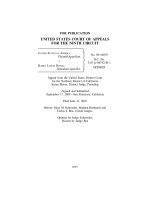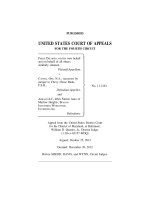PUBLISHED UNITED STATES COURT OF APPEALS FOR THE FOURTH CIRCUIT pdf
Bạn đang xem bản rút gọn của tài liệu. Xem và tải ngay bản đầy đủ của tài liệu tại đây (42.79 KB, 9 trang )
PUBLISHED
UNITED STATES COURT OF APPEALS
FOR THE FOURTH CIRCUIT
J
UDITH
J. M
OFFITT
,
Plaintiff-Appellant,
v.
No. 10-1316
R
ESIDENTIAL
F
UNDING
C
OMPANY
,
LLC; JP M
ORGAN
C
HASE
B
ANK
,
N.A.,
Defendants-Appellees.
L
YNN
A. F
ULMORE
,
Plaintiff-Appellant,
v.
P
REMIER
F
INANCIAL
C
ORPORATION
,
No. 10-1319
on behalf of Maximus Financial
Corporation; S
OVEREIGN
B
ANK
, a
U.S. Savings Bank,
Defendants-Appellees.
E
DWIN
R
UBLE
,
Plaintiff-Appellant,
v.
T
HE
M
ORTGAGE
C
ONSULTANTS
No. 10-1321
I
NCORPORATED
, a Maryland
Corporation; B
ANC
O
NE
F
INANCIAL
S
ERVICES
, I
NCORPORATED
,
Defendants-Appellees.
Appeals from the United States District Court
for the District of Maryland, at Baltimore.
J. Frederick Motz, District Judge.
(1:09-cv-02029-JFM; 1:09-cv-02028-JFM;
1:09-cv-02056-JFM)
Argued: March 26, 2010
Decided: May 3, 2010
Before WILKINSON, NIEMEYER, and SHEDD,
Circuit Judges.
Affirmed by published opinion. Judge Wilkinson wrote the
opinion, in which Judge Niemeyer and Judge Shedd joined.
COUNSEL
ARGUED: Edwin David Hoskins, THE LAW OFFICES OF
E. DAVID HOSKINS, LLC, Baltimore, Maryland, for Appel-
lants. James Christopher Martin, REED SMITH, LLP, Pitts-
2 M
OFFITT
v. R
ESIDENTIAL
F
UNDING
C
O
.
burgh, Pennsylvania, for Appellees. ON BRIEF: Thomas L.
Allen, John M. McIntyre, David J. de Jesus, REED SMITH
LLP, Pittsburgh, Pennsylvania, Gerard J. Gaeng, ROSEN-
BERG, MARTIN, GREENBERG, LLP, Baltimore, Mary-
land, for Appellees Residential Funding Company, LLC, and
Sovereign Bank; LeAnn Pedersen Pope, Victoria R. Collado,
Andrew D. LeMar, BURKE, WARREN, MACKAY & SER-
RITELLA, PC, Chicago, Illinois, for Appellees JP Morgan
Chase Bank, N.A., and Banc One Financial Services, Incorpo-
rated; Philip M. Andrews, Katrina J. Dennis, KRAMON &
GRAHAM, P.A., Baltimore, Maryland, for Appellee Premier
Financial Corporation; Alexander Y. Thomas, Richard D.
Holzheimer, REED SMITH LLP, Falls Church, Virginia,
Andrew C. Bernasconi, REED SMITH LLP, Washington,
D.C., for Appellee Banc One Financial Services, Incorpo-
rated.
OPINION
WILKINSON, Circuit Judge:
In these three interlocutory appeals, the plaintiffs challenge
the district court’s denial of their motions to remand their
cases to state court. While the procedural history of these
cases is involved, the legal issue is straightforward. After their
cases were removed and prior to moving to remand, the plain-
tiffs filed amended complaints in federal court that alleged
facts giving rise to federal diversity jurisdiction under the
Class Action Fairness Act of 2005 ("CAFA"), Pub. L. No.
109-2, 119 Stat. 4 (codified in scattered sections of 28
U.S.C.). Given these circumstances, we need not decide
whether the cases were improperly removed. Even assuming
that they were, we conclude that the amended complaints pro-
vided an independent basis for the district court to retain juris-
diction.
3M
OFFITT
v. R
ESIDENTIAL
F
UNDING
C
O
.
I.
The relevant facts in these three cases are as follows. In
2003, Judith Moffitt, Lynn Fulmore, and Edwin Ruble (col-
lectively, "plaintiffs") each filed individual complaints in
Maryland trial court alleging violations of the Maryland Sec-
ondary Mortgage Loan Law against various financial entities
(collectively, "defendants"). In 2006, the trial court dismissed
plaintiffs’ claims on the ground that they were barred by the
statute of limitations. But in 2009, the Maryland Court of
Appeals reversed, permitting the cases to go forward. Master
Fin., Inc. v. Crowder, 972 A.2d 864 (Md. 2009).
Following this decision, plaintiffs’ counsel sent defendants’
counsel a letter stating that plaintiffs intended to amend their
individual complaints into class actions. Enclosed with the
letter were draft copies of three amended class action com-
plaints. According to these complaints, each putative class
consisted of "thousands of members." While the draft com-
plaints did not specify the amounts in controversy, the letter
estimated that "the value of an individual claim will likely
range from $20,000 to $90,000."
Upon receiving these documents, defendants believed that
plaintiffs were alleging facts giving rise to federal diversity
jurisdiction under CAFA. See 28 U.S.C. § 1332(d). They fur-
ther believed that the draft complaints qualified as "other
paper[s]" under 28 U.S.C. § 1446(b), which provides that a
defendant may remove a case that was not initially removable
within thirty days of receiving "a copy of an amended plead-
ing, motion, order or other paper from which it may first be
ascertained that the case is one which is or has become
removable." Fearing that the thirty-day deadline would expire
before plaintiffs actually filed the amended complaints, defen-
dants went ahead and removed the cases to the United States
District Court for the District of Maryland.
After removal, plaintiffs filed final versions of their
amended class action complaints in the federal court. As
4 M
OFFITT
v. R
ESIDENTIAL
F
UNDING
C
O
.
plaintiffs acknowledge, these complaints satisfied the require-
ments for federal diversity jurisdiction under CAFA. 28
U.S.C. § 1332(d). Each complaint named at least one defen-
dant who was diverse in citizenship from at least one plaintiff,
§ 1332(d)(2)(A); sought aggregate damages in excess of
$5,000,000, exclusive of interests and costs, § 1332(d)(2), (6);
and alleged that there were at least one hundred class mem-
bers, § 1332(d)(5)(B). After plaintiffs filed these complaints,
defendants filed motions for leave to amend their original
notices of removal in order to base removal on plaintiffs’
actual filing of the complaints.
A few weeks after filing their amended class action com-
plaints, plaintiffs moved to remand the cases to state court. In
their view, neither the letter nor the enclosed draft complaints
that they sent to defendants qualified as "other paper[s]"
within the meaning of 28 U.S.C. § 1446(b). Thus, they
argued, defendants had jumped the gun by removing the cases
before plaintiffs had actually filed the amended complaints.
Without deciding whether removal had been improper, the
district court denied plaintiffs’ motions for remand. Moffitt v.
Balt. Am. Mortgage, 665 F. Supp. 2d 515 (D. Md. 2009). It
reasoned that by filing amended class action complaints alleg-
ing "facts that clearly give rise to federal jurisdiction," plain-
tiffs had waived their rights to seek remand. Id. at 517. In its
view, this ruling was supported by "considerations of sound
policy." Id. Had plaintiffs filed their amended complaints in
state court, it explained, "defendants could then have filed
renewed notices of removal, eliminating the ‘other paper’
issue upon which plaintiff[s’] current motions to remand are
based." Id. In the alternative, the district court granted defen-
dants’ motions for leave to amend their notices of removal. Id.
at 517 n.2.
Following the district court’s ruling, plaintiffs timely peti-
tioned this court for permission to file interlocutory appeals
5M
OFFITT
v. R
ESIDENTIAL
F
UNDING
C
O
.
under 28 U.S.C. § 1453(c)(1) of CAFA. We granted their
petitions on March 25, 2010.
II.
On appeal, plaintiffs’ principal argument is that the district
court was required to remand these cases because federal sub-
ject matter jurisdiction did not exist at the time of removal. In
their view, the district court should have given no consider-
ation to the fact that they filed amended complaints prior to
moving to remand. We review de novo the district court’s
denial of plaintiffs’ motions. Lontz v. Tharp, 413 F.3d 435,
439 (4th Cir. 2005).
The removal statute, 28 U.S.C. § 1441(a), requires that a
case "be fit for federal adjudication at the time the removal
petition is filed." Caterpillar Inc. v. Lewis, 519 U.S. 61, 73
(1996). But the mere fact that a case does not meet this timing
requirement is not "fatal to federal-court adjudication" where
jurisdictional defects are subsequently cured. Id. at 64. Thus,
if a plaintiff voluntarily amends his complaint to allege a basis
for federal jurisdiction, a federal court may exercise jurisdic-
tion even if the case was improperly removed. In Pegram v.
Herdrich, 530 U.S. 211 (2000), for instance, the Supreme
Court reasoned that because the plaintiff had amended her
complaint to add federal claims, "we therefore have jurisdic-
tion regardless of the correctness of the removal." Id. at 215
n.2. Likewise, in Cades v. H & R Block, Inc., 43 F.3d 869 (4th
Cir. 1994), this court found no need to address the plaintiff’s
argument that diversity jurisdiction was lacking at the time of
removal because the plaintiff had subsequently amended her
complaint to add claims which "firmly established" federal
jurisdiction. Id. at 873. As we explained, "an initial lack of the
right to removal may be cured when the final posture of the
case does not wrongfully extend federal jurisdiction." Id. (cit-
ing American Fire & Casualty Co. v. Finn, 341 U.S. 6, 16
(1951)).
6 M
OFFITT
v. R
ESIDENTIAL
F
UNDING
C
O
.
Other circuits have reached similar conclusions. See, e.g.,
Barbara v. N.Y. Stock Exch., Inc., 99 F.3d 49, 56 (2d Cir.
1996) ("[I]f a district court erroneously exercises removal
jurisdiction over an action, and the plaintiff voluntarily
amends the complaint to allege federal claims, we will not
remand for want of jurisdiction."); Bernstein v. Lind-Waldock
& Co., 738 F.2d 179, 185 (7th Cir. 1984) ("[O]nce [the plain-
tiff] decided to take advantage of his involuntary presence in
federal court to add a federal claim to his complaint he was
bound to remain there.").
Turning to the facts here, we assume without deciding that
these cases were removed at a time when they did not satisfy
federal subject matter jurisdiction. But even if they were,
plaintiffs independently conferred jurisdiction on the district
court by filing their amended class action complaints prior to
moving to remand. As plaintiffs acknowledge and the district
court stated, these complaints alleged "facts that clearly give
rise to federal jurisdiction" under CAFA. Moffitt, 665 F. Supp.
2d at 517.
Plaintiffs contend, however, that this line of precedent,
which excuses jurisdictional defects at the time of removal
when they are later cured, does not apply here. In their view,
the cases above were concerned solely with preventing parties
from attacking final judgments on the basis of improper
removals and are therefore inapplicable where, as here, a case
is taken up on interlocutory appeal. We disagree. As we have
recognized, this line of precedent is grounded not only in the
interest of "finality" but also in larger considerations of "judi-
cial economy." Able v. Upjohn Co., Inc., 829 F.2d 1330, 1334
(4th Cir. 1987), overruled on other grounds by Caterpillar,
519 U.S. at 74 n.11. In Caterpillar, for instance, the Court
emphasized that remanding the case after the jurisdictional
defect had been cured would "‘impose unnecessary and
wasteful burdens on the parties, judges, and other litigants.’"
519 U.S. at 76 (quoting Newman-Green, Inc. v. Alfonzo-
Larrain, 490 U.S. 826, 836 (1989)). While such concerns of
7M
OFFITT
v. R
ESIDENTIAL
F
UNDING
C
O
.
judicial economy are often implicated after a case reaches
final judgment, they are not confined to that situation. Requir-
ing pointless movement between state and federal court
before a case is tried on the merits can likewise impose signif-
icant costs on both courts and litigants. We thus see no need
to abandon this line of precedent simply because this case
happens to be before us on interlocutory appeal.
Here, it would be a waste of judicial resources to remand
these cases on the basis of an antecedent violation of the
removal statute now that jurisdiction has been established.
Were we to do so, defendants would almost certainly remove
the cases back to federal court in light of plaintiffs’ amended
class action complaints. Plaintiffs have expressed no intent to
abandon their class action complaints, and defendants would
thus be able to file renewed notices of removal once the cases
landed back in state court.* Moreover, defendants would not
have to worry about the normal one-year limitation on remov-
ing diversity cases since it does not apply to class actions. See
28 U.S.C. § 1453(b). Thus, these cases would likely end up in
federal court regardless of whether we ordered remands at this
juncture. Like the district court, we think that considerations
of judicial economy weigh against requiring such a pointless
exercise and in favor of allowing this case to go forward in
a federal forum where jurisdiction has been perfected.
Thus, we conclude that the district court did not err in
retaining jurisdiction after plaintiffs filed their amended class
action complaints. Having affirmed the district court’s ruling
on this basis, we need not address plaintiffs’ argument that the
*Plaintiffs contest this point. In their view, the thirty-day deadline for
removal started when they filed their amended class action complaints in
federal court and thus has long since expired. We, however, find it illogi-
cal to contend that a case becomes removable to federal court when it is
already in federal court. Thus, we think it plain that these cases would not
become removable until after they were remanded to state court, assuming
of course that defendants’ initial removal was improper.
8 M
OFFITT
v. R
ESIDENTIAL
F
UNDING
C
O
.
district court erred in granting defendants leave to amend their
initial notices of removal.
III.
Accordingly, the district court’s order is
AFFIRMED.
9M
OFFITT
v. R
ESIDENTIAL
F
UNDING
C
O
.









